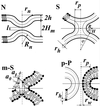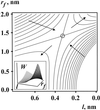A quantitative model for membrane fusion based on low-energy intermediates
- PMID: 11404463
- PMCID: PMC34652
- DOI: 10.1073/pnas.121191898
A quantitative model for membrane fusion based on low-energy intermediates
Abstract
The energetics of a fusion pathway is considered, starting from the contact site where two apposed membranes each locally protrude (as "nipples") toward each other. The equilibrium distance between the tips of the two nipples is determined by a balance of physical forces: repulsion caused by hydration and attraction generated by fusion proteins. The energy to create the initial stalk, caused by bending of cis monolayer leaflets, is much less when the stalk forms between nipples rather than parallel flat membranes. The stalk cannot, however, expand by bending deformations alone, because this would necessitate the creation of a hydrophobic void of prohibitively high energy. But small movements of the lipids out of the plane of their monolayers allow transformation of the stalk into a modified stalk. This intermediate, not previously considered, is a low-energy structure that can reconfigure into a fusion pore via an additional intermediate, the prepore. The lipids of this latter structure are oriented as in a fusion pore, but the bilayer is locally compressed. All membrane rearrangements occur in a discrete local region without creation of an extended hemifusion diaphragm. Importantly, all steps of the proposed pathway are energetically feasible.
Figures




Similar articles
-
The mechanisms of lipid-protein rearrangements during viral infection.Bioelectrochemistry. 2004 Jun;63(1-2):129-36. doi: 10.1016/j.bioelechem.2003.10.016. Bioelectrochemistry. 2004. PMID: 15110263 Review.
-
Energetics of vesicle fusion intermediates: comparison of calculations with observed effects of osmotic and curvature stresses.Biophys J. 2004 May;86(5):2951-64. doi: 10.1016/S0006-3495(04)74346-5. Biophys J. 2004. PMID: 15111411 Free PMC article.
-
Calculating Transition Energy Barriers and Characterizing Activation States for Steps of Fusion.Biophys J. 2016 Mar 8;110(5):1110-24. doi: 10.1016/j.bpj.2016.01.013. Biophys J. 2016. PMID: 26958888 Free PMC article.
-
Stalk model of membrane fusion: solution of energy crisis.Biophys J. 2002 Feb;82(2):882-95. doi: 10.1016/S0006-3495(02)75450-7. Biophys J. 2002. PMID: 11806930 Free PMC article.
-
The energetics of membrane fusion from binding, through hemifusion, pore formation, and pore enlargement.J Membr Biol. 2004 May 1;199(1):1-14. doi: 10.1007/s00232-004-0669-8. J Membr Biol. 2004. PMID: 15366419 Review.
Cited by
-
Measuring single-virus fusion kinetics using an assay for nucleic acid exposure.Biophys J. 2022 Dec 6;121(23):4467-4475. doi: 10.1016/j.bpj.2022.11.002. Epub 2022 Nov 9. Biophys J. 2022. PMID: 36330566 Free PMC article.
-
Class II fusion proteins.Adv Exp Med Biol. 2013;790:150-66. doi: 10.1007/978-1-4614-7651-1_8. Adv Exp Med Biol. 2013. PMID: 23884590 Free PMC article. Review.
-
Control of membrane fusion mechanism by lipid composition: predictions from ensemble molecular dynamics.PLoS Comput Biol. 2007 Nov;3(11):e220. doi: 10.1371/journal.pcbi.0030220. Epub 2007 Sep 26. PLoS Comput Biol. 2007. PMID: 18020701 Free PMC article.
-
Common principles and intermediates of viral protein-mediated fusion: the HIV-1 paradigm.Retrovirology. 2008 Dec 10;5:111. doi: 10.1186/1742-4690-5-111. Retrovirology. 2008. PMID: 19077194 Free PMC article. Review.
-
Fusion Peptide of SARS-CoV-2 Spike Rearranges into a Wedge Inserted in Bilayered Micelles.J Am Chem Soc. 2021 Aug 25;143(33):13205-13211. doi: 10.1021/jacs.1c05435. Epub 2021 Aug 10. J Am Chem Soc. 2021. PMID: 34375093 Free PMC article.
References
-
- Chernomordik L V, Melikyan G B, Chizmadzhev Yu A. Biochem Biophys Acta. 1987;906:309–352. - PubMed
-
- Frolov V A, Cho M-S, Bronk P, Reese T S, Zimmerberg J. Traffic. 2000;1:622–630. - PubMed
-
- Gingell D, Ginsberg L. In: Membrane Fusion. Poste G, Nicholson G L, editors. Amsterdam: Elsevier; 1978. pp. 791–833.
-
- Kozlov M M, Markin V S. Biofizika. 1983;28:255–261. - PubMed
-
- Markin V S, Kozlov M M, Borovjagin V L. Gen Physiol Biophys. 1984;5:361–377. - PubMed
Publication types
MeSH terms
Substances
Grants and funding
LinkOut - more resources
Full Text Sources
Other Literature Sources

